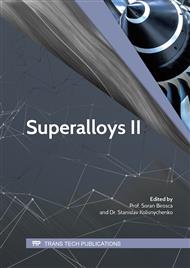p.1570
p.1574
p.1579
p.1585
p.1591
p.1597
p.1603
p.1607
p.1613
Deformation Twinning Behavior in High Ni-Austenitic Materials
Abstract:
Deformation twinning behaviors have been studied in high Ni alloys, Alloy 28 or Sanicro 28 and Alloy 625 at RT and at cryogenic temperature. The microstructures were evaluated using SEM-EBSD. Some constitutive approach has also been used in the discussion on the deformation twinning in high Ni-alloys. The results show that deformation twinning can occur in high Ni alloys depending on the chemical composition, strain range and stress conditions. TWIP can occur in the Ni based superalloy Alloy 625 at cryogenic temperature, which increases both strength and ductility. This is the first report of this phenomena for this alloy. Deformation twinning in high Ni alloys occurs heterogeneously in the material, depending on crystallographic parameters such as grain orientation and Schmid factor. Formation of deformation twins can lead to high texture in the material, which will contribute to the increase of strength. The mechanisms for the formation of deformation twins in high Ni alloys have been discussed.
Info:
Periodical:
Pages:
1591-1596
Citation:
Online since:
December 2018
Authors:
Keywords:
Price:
Сopyright:
© 2018 Trans Tech Publications Ltd. All Rights Reserved
Share:
Citation:



